Compounds for inhibiting AGC kinase and pharmaceutical compositions comprising the same
Chen , et al. June 30, 2
U.S. patent number 10,696,638 [Application Number 16/206,000] was granted by the patent office on 2020-06-30 for compounds for inhibiting agc kinase and pharmaceutical compositions comprising the same. This patent grant is currently assigned to INDUSTRIAL TECHNOLOGY RESEARCH INSTITUTE. The grantee listed for this patent is Industrial Technology Research Institute. Invention is credited to Chih-Hung Chen, Yi-Hsun Chen, Jui-Wen Huang, Kuo-Kuei Huang, Chrong-Shiong Hwang, Chih-Peng Liu.
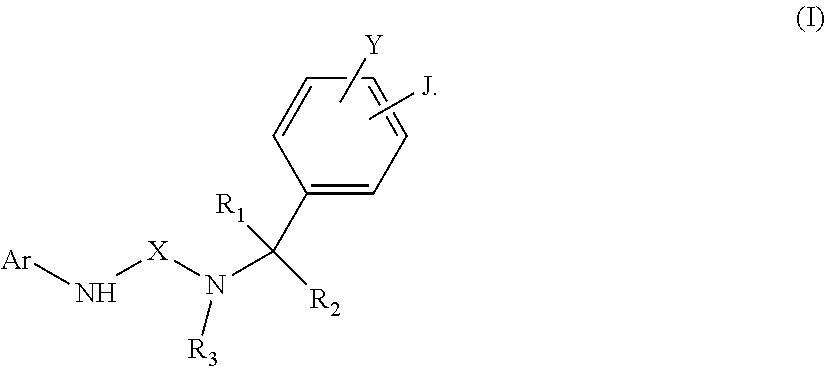


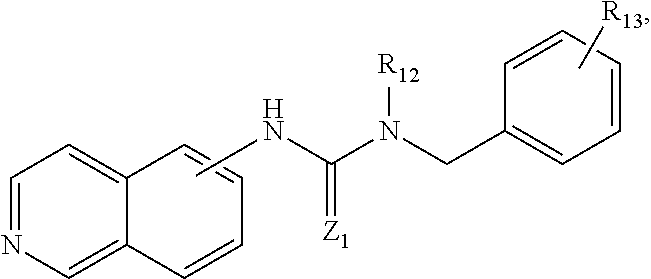


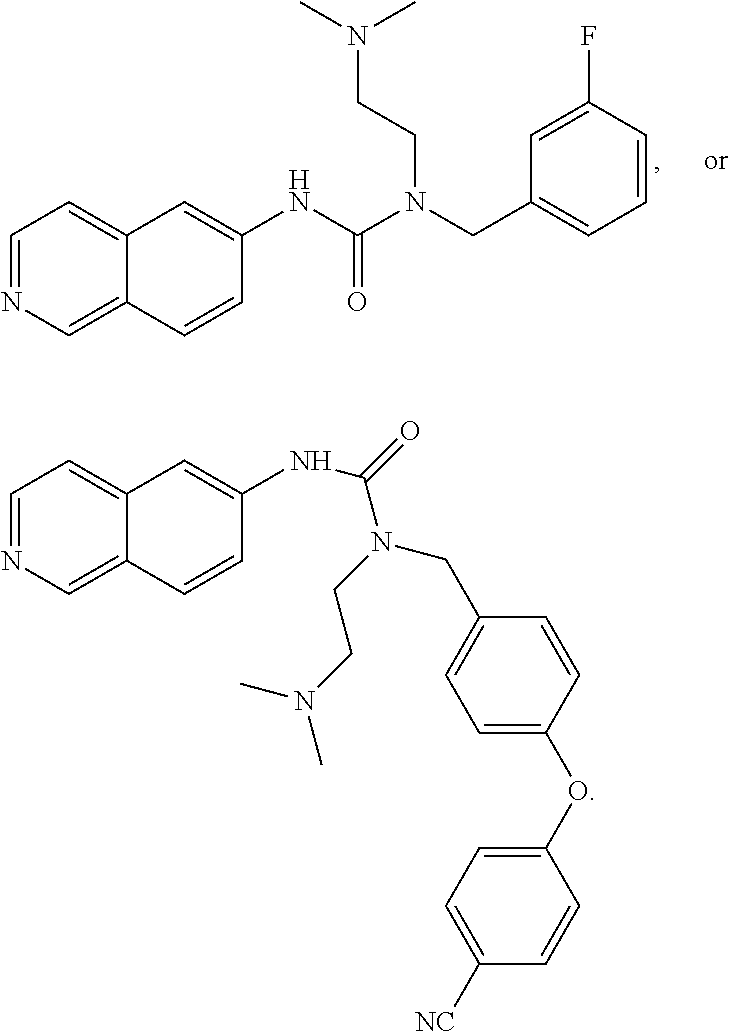





View All Diagrams
| United States Patent | 10,696,638 |
| Chen , et al. | June 30, 2020 |
Compounds for inhibiting AGC kinase and pharmaceutical compositions comprising the same
Abstract
A compound of formula (I) or a pharmaceutically acceptable salt thereof is provided. In formula (I), Ar is indazole, 5-isoquinoline, 6-isoquinoline, or their N-oxide. X is --C(.dbd.Z)--, wherein Z is N--CN, NH, NR.sub.4, NCOR.sub.4, NCONR.sub.4R.sub.5, NCO-aryl, S, or O. Y and J are independently H, alkyl, aryl, aminoalkyl, --NH.sub.2, --CN, --OH, --O-alkyl, --O-aryl, --COOH, --COOR.sub.4, --CONHR.sub.4, --CONHCH.sub.2-aryl, --CONR.sub.4CH.sub.2-aryl, --NHCOR.sub.4, halogen, halogened alkyl, -alkyl-OR.sub.4, -alkyl-ONO.sub.2, alkyl-ONO.sub.2, --OCOOR.sub.4, --O(C.dbd.O)-aryl, --CHR.sub.4OH, --CH.sub.2OH, --CH.sub.2O(C.dbd.O)-aryl, --CH.sub.2O(C.dbd.O)--R.sub.4, --CHR.sub.4O(C.dbd.O)-aryl, --CHR.sub.4O(C.dbd.O)--R.sub.4, unsaturated carboxylic ester, substituted alkynyl, --NHSO.sub.2R.sub.4, --SO.sub.2R.sub.4, --SO.sub.2NHR.sub.4, or --SO.sub.2NR.sub.4R.sub.5, or Y and J bond together to form a carbocylic or aromatic ring, wherein R.sub.4 and R.sub.5 are independently H, substituted C1-C6 alkyl, substituted aryl, cycloalkyl, alkylaryl, -alkyl-NR.sub.6R.sub.7, --S(O).sub.0-2-(alkyl-NR.sub.6R.sub.7). R.sub.1, R.sub.2 and R.sub.3 are H, C1-C6 alkyl, cycloalkyl, aryl, alkylaryl, alkylheteroaryl, alkylheterocycle, wherein any one thereof is optionally substituted with one or more of OH, NO.sub.2, or NR.sub.8R.sub.9. ##STR00001##
| Inventors: | Chen; Chih-Hung (Tainan, TW), Chen; Yi-Hsun (Hsinchu, TW), Huang; Jui-Wen (Zhubei, TW), Huang; Kuo-Kuei (Zhubei, TW), Liu; Chih-Peng (Hsinchu, TW), Hwang; Chrong-Shiong (Hsinchu, TW) | ||||||||||
|---|---|---|---|---|---|---|---|---|---|---|---|
| Applicant: |
|
||||||||||
| Assignee: | INDUSTRIAL TECHNOLOGY RESEARCH
INSTITUTE (Hsinchu, TW) |
||||||||||
| Family ID: | 64746410 | ||||||||||
| Appl. No.: | 16/206,000 | ||||||||||
| Filed: | November 30, 2018 |
Prior Publication Data
| Document Identifier | Publication Date | |
|---|---|---|
| US 20190194137 A1 | Jun 27, 2019 | |
Related U.S. Patent Documents
| Application Number | Filing Date | Patent Number | Issue Date | ||
|---|---|---|---|---|---|
| 62610446 | Dec 26, 2017 | ||||
| Current U.S. Class: | 1/1 |
| Current CPC Class: | A61K 31/4725 (20130101); A61K 31/472 (20130101); C07D 217/02 (20130101); A61P 27/02 (20180101); A61K 9/0048 (20130101); A61K 9/08 (20130101) |
| Current International Class: | C07D 217/02 (20060101); A61K 31/4725 (20060101); A61P 27/02 (20060101); A61K 31/472 (20060101); A61K 9/08 (20060101); A61K 9/00 (20060101) |
| Field of Search: | ;546/143 |
References Cited [Referenced By]
U.S. Patent Documents
| 4785008 | November 1988 | Coquelet et al. |
| 8153792 | April 2012 | Moussy et al. |
| 8278335 | October 2012 | Machacek et al. |
| 8367706 | February 2013 | Altman et al. |
| 8394826 | March 2013 | deLong et al. |
| 8455514 | June 2013 | deLong et al. |
| 8912209 | December 2014 | Leysen et al. |
| 9713613 | July 2017 | Uesugi et al. |
| 2003/0158198 | August 2003 | Lee et al. |
| 2005/0113576 | May 2005 | Lee et al. |
| 2007/0173530 | July 2007 | deLong |
| 2008/0167340 | July 2008 | deLong et al. |
| 2010/0041671 | February 2010 | Nakajima et al. |
| 2013/0131059 | May 2013 | Lampe et al. |
| 2013/0177655 | July 2013 | Sugimoto et al. |
| 201134825 | Oct 2011 | TW | |||
| WO 02/057233 | Jul 2002 | WO | |||
| WO 03/062215 | Jul 2003 | WO | |||
| 2003080578 | Oct 2003 | WO | |||
| WO 03/080578 | Oct 2003 | WO | |||
| WO 2005/105069 | Nov 2005 | WO | |||
| WO 2007/000240 | Jan 2007 | WO | |||
| WO 2007/026920 | Mar 2007 | WO | |||
| WO 2008/110846 | Sep 2008 | WO | |||
Other References
|
Wu et al., Bioorg. Med. Chem. Letters (2010), vol. 20(11), pp. 3235-3239. cited by examiner . Chen et al. "Chroman-3-amides as potent Rho kinase inhibitors", Bioorganic & Medicinal Chemistry Letters, 18, (2008), p. 6406-6409. cited by applicant . Donegan et al. "Discovery of molecular therapeutics for glaucoma: Challenges, successes, and promising directions", J Med Chem., Feb. 11, 2016, 59, (3), p. 788-809. cited by applicant . Feng et al. "Discovery of Substituted 4-(Pyrazol-4-yl)-phenylbenzodioxane-2-carboxamides as Potent and Highly Selective Rho Kinase (ROCK-II) Inhibitors", J. Med. Chem., 2008, 51, (21), p. 6642-6645. cited by applicant . Guan et al. "Advances in the studies of roles of Rho/Rho-kinase in diseases and the development of its inhibitors", European Journal of Medicinal Chemistry, 70, (2013), p. 613-622. cited by applicant . Henderson et al. "2,3-Diaminopyrazines as rho kinase inhibitors", Bioorganic & Medicinal Chemistry Letters, 20, (2010), p. 1137-1140. cited by applicant . Iwakubo et al. "Design and synthesis of Rho kinase inhibitors (II)", ScienceDirect, Bioorganic & Medicinal Chemistry, 15, (2007), p. 350-364. cited by applicant . Iwakubo et al. "Design and synthesis of rho kinase inhibitors (III)", ScienceDirect, Bioorganic & Medicinal Chemistry, 15, (2007), p. 1022-1033. cited by applicant . Morwick et al. "Hit to Lead Account of the Discovery of Bisbenzamide and Related Ureidobenzamide Inhibitors of Rho Kinase", J. Med. Chem., 2010, 53, p. 759-777. cited by applicant . Sehon et al. "Potent, Selective and Orally Bioavailable Dihydropyrimidine Inhibitors of Rho Kinase (ROCK1) as Potential Therapeutic Agents for Cardiovascular Diseases", J. Med. Chem., 2008, 51, p. 6631-6634. cited by applicant . Stavenger et al. "Discovery of Aminofurazan-azabenzimidazoles as Inhibitors of Rho-Kinase with High Kinase Selectivity and Antihypertensive Activity", J. Med. Chem., 2007, 50, p. 2-5. cited by applicant . Takami et al. "Design and synthesis of Rho kinase inhibitors (I)", ScienceDirect, Bioorganic & Medicinal Chemistry, 12, (2004), p. 2115-2137. cited by applicant . Extended European Search Report for European Application No. 18214556.5, dated Feb. 13, 2019. cited by applicant . LoGrasso et al., "Rho Kinase (ROCK) Inhibitors and Their Application to Inflammatory Disorders," Current Topics in Medicinal Chemistry, vol. 9, No. 8, 2009, pp. 704-723. cited by applicant. |
Primary Examiner: Solola; Taofiq A
Attorney, Agent or Firm: Birch, Stewart, Kolasch & Birch, LLP
Parent Case Text
CROSS REFERENCE TO RELATED APPLICATIONS
This application claims the benefit of U.S. Provisional Application No. 62/610,446, filed on Dec. 26, 2017, the entirety of which is incorporated by reference herein.
Claims
What is claimed is:
1. A compound of formula (I), or a pharmaceutically acceptable salt thereof: ##STR00077## wherein Ar is, 5-isoquinoline, 6-isoquinoline, or their N-oxide, X is --C(.dbd.Z)--, wherein Z is N--CN, NH, NR.sub.4, NCOR.sub.4, NCONR.sub.4R.sub.5, NCO-aryl, or S, Y and J are independently H, C.sub.1-C.sub.6 alkyl, C.sub.6-C.sub.8 aryl, C.sub.1-C.sub.6 aminoalkyl, --NH.sub.2, --CN, --OH, --O-alkyl, --O-aryl, --COOH, --COOR.sub.4, --CONHR.sub.4, --CONHCH.sub.2-aryl, --CONR.sub.4CH.sub.2-aryl, --NHCOR.sub.4, halogen, C.sub.1-C.sub.6 halogened alkyl, -alkyl-OR.sub.4, --O-alkyl-OR.sub.4, -alkyl-ONO.sub.2, --O-alkyl-ONO.sub.2, --OCOOR.sub.4, --O(C.dbd.O)-aryl, --CHR.sub.4OH, --CH.sub.2OH, --CH.sub.2O(C.dbd.O)-aryl, --CH.sub.2O(C.dbd.O)--R.sub.4, --CHR.sub.4O(C.dbd.O)-aryl, --CHR.sub.4O(C.dbd.O)--R.sub.4, unsaturated carboxylic ester, C.sub.2-C.sub.12 alkynyl, substituted C.sub.2-C.sub.12 alkynyl, --NHSO.sub.2R.sub.4, --SR.sub.4, --SO.sub.2R.sub.4, --SO.sub.2NHR.sub.4, or --SO.sub.2NR.sub.4R.sub.5, wherein R.sub.4 and R.sub.5 are independently H, C.sub.1-C.sub.6 alkyl, C.sub.6-C.sub.8 aryl, substituted C.sub.1-C.sub.6 alkyl, substituted C.sub.6-C.sub.8 aryl, C.sub.5-C.sub.12 cycloalkyl, C.sub.7-C.sub.12 alkylaryl, -alkyl-NR.sub.6R.sub.7, -alkyl-OR.sub.6, -alkyl-ONO.sub.2, --S(O).sub.0-2-(alkyl-NR.sub.6R.sub.7), wherein R.sub.6 and R.sub.7 are independently H, alkyl, aryl or bond together with nitrogen atom to form a heterocyclic ring, and R.sub.1, R.sub.2 and R.sub.3 are H, C.sub.1-C.sub.6 alkyl, cycloalkyl, aryl, alkylaryl, alkylheteroaryl, alkylheterocycle, wherein any one thereof is optionally substituted with one or more of OH, ONO.sub.2, or NR.sub.8R.sub.9, wherein R.sub.8 and R.sub.9 are independently H, C.sub.1-C.sub.6 alkyl, C.sub.6-C.sub.8 aryl or bond together with nitrogen atom to form a heterocyclic ring.
2. The compound as claimed in claim 1, wherein the pharmaceutically acceptable salt of the compound comprises a salt form of HCl, CH.sub.3SO.sub.3H, tartaric acid, maleic acid, fumaric acid, malic acid or lactic acid.
3. The compound as claimed in claim 1, wherein the compound comprises a prodrug, an optical isomer or a racemic mixture thereof.
4. The compound as claimed in claim 1, wherein R.sub.1, R.sub.2 and R.sub.3 are --(CH.sub.2).sub.nNR.sub.10R.sub.11 or --(CH.sub.2).sub.nOH, wherein R.sub.10 and R.sub.11 are independently H, C.sub.1-C.sub.6 alkyl, C.sub.6-C.sub.8 aryl or bond together with nitrogen atom to form a C.sub.5-C.sub.10 heterocyclic ring, and n is an integer from 1 to 6.
5. The compound as claimed in claim 1, wherein R.sub.8 and R.sub.9 bond together with nitrogen atom to form a C.sub.3-C.sub.10 heterocyclic ring.
6. The compound as claimed in claim 1, wherein R.sub.6 and R.sub.7 are independently H, C.sub.1-C.sub.6 alkyl, C.sub.6-C.sub.8 aryl or bond together with nitrogen atom to form a C.sub.5-C.sub.10 heterocyclic ring.
7. The compound as claimed in claim 1, wherein the compound is ##STR00078## wherein R.sub.13 is H, C.sub.1-C.sub.6 alkyl, C.sub.6-C.sub.8 aryl, C.sub.1-C.sub.6 aminoalkyl, --NH.sub.2, --CN, --OH, --O-alkyl, --O-aryl, --COOH, --COOR.sub.14, --CONHR.sub.14, --CONHCH.sub.2-aryl, --CONR.sub.14CH.sub.2-aryl, --NHCOR.sub.14, halogen, C.sub.1-C.sub.6 halogened alkyl, -alkyl-OR.sub.14, --O-alkyl-OR.sub.14, O-alkyl-ONO.sub.2, O-alkyl-ONO.sub.2, OCOOR.sub.14, --O(C.dbd.O)-aryl, --CHR.sub.14OH, --CH.sub.2OH, --CH.sub.2O(C.dbd.O)-aryl, --CH.sub.2O(C.dbd.O)--R.sub.4, --CHR.sub.14O(C.dbd.O)-aryl, --CHR.sub.14O(C.dbd.O)--R.sub.14, wherein R.sub.14 is H, C.sub.1-C.sub.6 alkyl, C.sub.6-C.sub.8 aryl, C.sub.5-C.sub.12 cycloalkyl, C.sub.6-C.sub.12 alkylaryl, and R.sub.12 is --H, C.sub.1-C.sub.6 alkyl, --(CH.sub.2).sub.nNR.sub.15R.sub.16 or --(CH.sub.2).sub.nOH, wherein R.sub.15 and R.sub.16 are independently H, C.sub.1-C.sub.6 alkyl, C.sub.6-C.sub.8 aryl or bond together with nitrogen atom to form a C.sub.5-C.sub.10 heterocyclic ring, and Z.sub.1 is N--CN, NH, NR.sub.17, NCOR.sub.17, NCONR.sub.17R.sub.18, NCO-aryl, S, or O, wherein R.sub.17 and R.sub.18 are independently H, C.sub.1-C.sub.6 alkyl, C.sub.6-C.sub.8 aryl, substituted C.sub.1-C.sub.6 alkyl, substituted C.sub.6-C.sub.8 aryl, C.sub.5-C.sub.12 cycloalkyl, or C.sub.7-C.sub.12 alkylaryl.
8. The compound as claimed in claim 1, wherein the compound is ##STR00079## wherein R.sub.20 is H, C.sub.1-C.sub.6 alkyl, C.sub.6-C.sub.8 aryl, C.sub.1-C.sub.6 aminoalkyl, --NH.sub.2, --CN, --OH, --O-alkyl, --O-aryl, --COOH, --COOR.sub.21, --CONHR.sub.21, --CONHCH.sub.2-aryl, --CONR.sub.21CH.sub.2-aryl, --NHCOR.sub.21, halogen, C.sub.1-C.sub.6 halogened alkyl, -alkyl-OR.sub.21, --O-alkyl-OR.sub.21, -alkyl-ONO.sub.2, O-alkyl-ONO.sub.2, --OCOOR.sub.21, --O(C.dbd.O)-aryl, --CHR.sub.21OH, --CH.sub.2OH, --CH.sub.2O(C.dbd.O)-aryl, --CH.sub.2O(C.dbd.O)--R.sub.4, --CHR.sub.21O(C.dbd.O)-aryl, --CHR.sub.4O(C.dbd.O)--R.sub.21, wherein R.sub.21 is H, C.sub.1-C.sub.6 alkyl, C.sub.6-C.sub.8 aryl, C.sub.5-C.sub.12 cycloalkyl, C.sub.6-C.sub.12 alkylaryl, and R.sub.19 is --H, C.sub.1-C.sub.6 alkyl, --(CH.sub.2).sub.nNR.sub.22R.sub.23 or --(CH.sub.2).sub.nOH, wherein R.sub.22 and R.sub.23 are independently H, C.sub.1-C.sub.6 alkyl, C.sub.6-C.sub.8 aryl or bond together with nitrogen atom to form a C.sub.5-C.sub.10 heterocyclic ring, and Z.sub.2 is N--CN, NH, NR.sub.24, NCOR.sub.24, NCONR.sub.24R.sub.25, NCO-aryl, S, or O, wherein R.sub.24 and R.sub.25 are independently H, C.sub.1-C.sub.6 alkyl, C.sub.6-C.sub.8 aryl, substituted C.sub.1-C.sub.6 alkyl, substituted C.sub.6-C.sub.8 aryl, C.sub.5-C.sub.12 cycloalkyl, C.sub.7-C.sub.12 alkylaryl.
Description
TECHNICAL FIELD
The disclosure relates to a compound for inhibiting AGC kinase or a pharmaceutically acceptable salt thereof, and a pharmaceutical composition comprising the same.
BACKGROUND
AGC kinase has become an attractive target for the treatment of many diseases such as hypertension, stroke, cancer and glaucoma.
Therefore, development of novel AGC kinase inhibitors with improved inhibitory activity is desired.
SUMMARY
In accordance with one embodiment of the disclosure, a compound of formula (I) or a pharmaceutically acceptable salt thereof is provided.
##STR00002##
In formula (I), Ar is indazole, 5-isoquinoline, 6-isoquinoline, or their N-oxide, X is --C(.dbd.Z)--, wherein Z is N--CN, NH, NR.sub.4, NCOR.sub.4, NCONR.sub.4R.sub.5, NCO-aryl, S, or O, Y and J are independently H, C.sub.1-C.sub.6 alkyl, C.sub.6-C.sub.8 aryl, C.sub.1-C.sub.6 aminoalkyl, --NH.sub.2, --CN, --OH, --O-alkyl, --O-aryl, --COOH, --COOR.sub.4, --CONHR.sub.4, --CONHCH.sub.2-aryl, --CONR.sub.4CH.sub.2-aryl, --NHCOR.sub.4, halogen, C.sub.1-C.sub.6 halogened alkyl, -alkyl-OR.sub.4, -alkyl-ONO.sub.2, --O-alkyl-ONO.sub.2, --OCOOR.sub.4, --O(C.dbd.O)-aryl, --CHR.sub.4OH, --CH.sub.2OH, --CH.sub.2O(C.dbd.O)-aryl, --CH.sub.2O(C.dbd.O)--R.sub.4, --CHR.sub.4O(C.dbd.O)-aryl, --CHR.sub.4O(C.dbd.O)--R.sub.4, unsaturated carboxylic ester, C.sub.2-C.sub.12 alkynyl, substituted C.sub.2-C.sub.12 alkynyl, --NHSO.sub.2R.sub.4, --SR.sub.4, --SO.sub.2R.sub.4, --SO.sub.2NHR.sub.4, or --SO.sub.2NR.sub.4R.sub.5, or Y and J bond together to form a carbocylic or aromatic ring, wherein R.sub.4 and R.sub.5 are independently H, C.sub.1-C.sub.6 alkyl, C.sub.6-C.sub.8 aryl, substituted C.sub.1-C.sub.6 alkyl, substituted C.sub.6-C.sub.8 aryl, C.sub.5-C.sub.12 cycloalkyl, C.sub.7-C.sub.12 alkylaryl, -alkyl-NR.sub.6R.sub.7, -alkyl-OR.sub.6, -alkyl-ONO.sub.2, --S(O).sub.0-2-(alkyl-NR.sub.6R.sub.7), wherein R.sub.6 and R.sub.7 are independently H, alkyl, aryl or bond together with nitrogen atom to form a heterocyclic ring, and R.sub.1, R.sub.2 and R.sub.3 are H, C.sub.1-C.sub.6 alkyl, cycloalkyl, aryl, alkylaryl, alkylheteroaryl, alkylheterocycle, wherein any one thereof is optionally substituted with one or more of OH, ONO.sub.2, or NR.sub.8R.sub.9, wherein R.sub.8 and R.sub.9 are independently H, C.sub.1-C.sub.6 alkyl, C.sub.6-C.sub.8 aryl or bond together with nitrogen atom to form a heterocyclic ring.
In accordance with one embodiment of the disclosure, a pharmaceutical composition is provided. The pharmaceutical composition comprises an effective amount of the compound of formula (I) or a pharmaceutically acceptable salt thereof, and a pharmaceutically acceptable carrier.
A detailed description is given in the following embodiments.
DETAILED DESCRIPTION
The following description is of the best-contemplated mode of carrying out the disclosure. This description is made for the purpose of illustrating the general principles of the disclosure and should not be taken in a limiting sense. The scope of the disclosure is best determined by reference to the appended claims.
In the disclosure, molecular docking and three-dimensional quantitative structure-activity relationship are performed to design a new series of selective AGC inhibitors.
In the disclosure, a new series of selective AGC inhibitors based on, for example, pyridine, indazole or isoquinoline derivatives, is developed. An object of the present disclosure is to provide a preventing or treating agent for ophthalmic disorders. These compounds contain structural feature render them suitable for use in topical formulations. The structures described herein provide new compounds with therapeutically utility.
In accordance with one embodiment of the disclosure, a compound of formula (I) or a pharmaceutically acceptable salt thereof is provided.
##STR00003##
In formula (I), Ar is indazole, 5-isoquinoline, 6-isoquinoline, or their N-oxide, X is --C(.dbd.Z)--, wherein Z is N--CN, NH, NR.sub.4, NCOR.sub.4, NCONR.sub.4R.sub.5, NCO-aryl, S, or O, Y and J are independently H, C.sub.1-C.sub.6 alkyl, C.sub.6-C.sub.8 aryl, C.sub.1-C.sub.6 aminoalkyl, --NH.sub.2, --CN, --OH, --O-alkyl, --O-aryl, --COOH, --COOR.sub.4, --CONHR.sub.4, --CONHCH.sub.2-aryl, --CONR.sub.4CH.sub.2-aryl, --NHCOR.sub.4, halogen, C.sub.1-C.sub.6 halogened alkyl, -alkyl-OR.sub.4, -alkyl-ONO.sub.2, --O-alkyl-ONO.sub.2, --OCOOR.sub.4, --O(C.dbd.O)-aryl, --CHR.sub.4OH, --CH.sub.2OH, --CH.sub.2O(C.dbd.O)-aryl, --CH.sub.2O(C.dbd.O)--R.sub.4, --CHR.sub.4O(C.dbd.O)-aryl, --CHR.sub.4O(C.dbd.O)--R.sub.4, unsaturated carboxylic ester, C.sub.2-C.sub.12 alkynyl, substituted C.sub.2-C.sub.12 alkynyl, --NHSO.sub.2R.sub.4, --SR.sub.4, --SO.sub.2R.sub.4, --SO.sub.2NHR.sub.4, or --SO.sub.2NR.sub.4R.sub.5, or Y and J bond together to form a carbocylic or aromatic ring, wherein R.sub.4 and R.sub.5 are independently H, C.sub.1-C.sub.6 alkyl, C.sub.6-C.sub.8 aryl, substituted C.sub.1-C.sub.6 alkyl, substituted C.sub.6-C.sub.8 aryl, C.sub.5-C.sub.12 cycloalkyl, C.sub.7-C.sub.12 alkylaryl, -alkyl-NR.sub.6R.sub.7, -alkyl-OR.sub.6, -alkyl-ONO.sub.2, --S(O).sub.0-2-(alkyl-NR.sub.6R.sub.7), wherein R.sub.6 and R.sub.7 are independently H, alkyl, aryl or bond together with nitrogen atom to form a heterocyclic ring, and R.sub.1, R.sub.2 and R.sub.3 are H, C.sub.1-C.sub.6 alkyl, cycloalkyl, aryl, alkylaryl, alkylheteroaryl, alkylheterocycle, wherein any one thereof is optionally substituted with one or more of OH, ONO.sub.2, or NR.sub.8R.sub.9, wherein R.sub.8 and R.sub.9 are independently H, C.sub.1-C.sub.6 alkyl, C.sub.6-C.sub.8 aryl or bond together with nitrogen atom to form a heterocyclic ring.
In some embodiments, the pharmaceutically acceptable salt of the compound may comprise a salt form of such as HCl, CH.sub.3SO.sub.3H, tartaric acid, maleic acid, fumaric acid, malic acid, lactic acid or p-TSA.
In some embodiments, R.sub.1, R.sub.2 and R.sub.3 may be --(CH.sub.2).sub.nNR.sub.10R.sub.11 or --(CH.sub.2).sub.nOH, wherein R.sub.10 and R.sub.11 are independently H, C.sub.1-C.sub.6 alkyl, C.sub.6-C.sub.8 aryl or bond together with nitrogen atom to form a C.sub.5-C.sub.10 heterocyclic ring, and n is an integer from 1 to 6.
In some embodiments, R.sub.8 and R.sub.9 may be bond together with nitrogen atom to form a C.sub.3-C.sub.10 heterocyclic ring.
In some embodiments, R.sub.6 and R.sub.7 may be independently H, C.sub.1-C.sub.6 alkyl, C.sub.6-C.sub.8 aryl or bond together with nitrogen atom to form a C.sub.5-C.sub.10 heterocyclic ring.
In some embodiments, the compound may be
##STR00004## wherein R.sub.13 is H, C.sub.1-C.sub.6 alkyl, C.sub.6-C.sub.8 aryl, C.sub.1-C.sub.6 aminoalkyl, --NH.sub.2, --CN, --OH, --O-alkyl, --O-aryl, --COOH, --COOR.sub.14, --CONHR.sub.14, --CONHCH.sub.2-aryl, --CONR.sub.14CH.sub.2-aryl, --NHCOR.sub.14, halogen, C.sub.1-C.sub.6 halogened alkyl, -alkyl-OR.sub.14, --O-alkyl-OR.sub.14, -alkyl-ONO.sub.2, O-alkyl-ONO.sub.2, --OCOOR.sub.14, --O(C.dbd.O)-aryl, --CHR.sub.14OH, --CH.sub.2OH, --CH.sub.2O(C.dbd.O)-aryl, --CH.sub.2O(C.dbd.O)--R.sub.4, --CHR.sub.14, --O(C.dbd.O)-aryl, --CHR.sub.4O(C.dbd.O)--R.sub.14, wherein R.sub.14 is H, C.sub.1-C.sub.6 alkyl, C.sub.6-C.sub.8 aryl, C.sub.5-C.sub.12 cycloalkyl, C.sub.6-C.sub.12 alkylaryl, and R.sub.12 is --H, C.sub.1-C.sub.6 alkyl, --(CH.sub.2).sub.nNR.sub.15R.sub.16 or --(CH.sub.2).sub.nOH, wherein R.sub.15 and R.sub.16 are independently H, C.sub.1-C.sub.6 alkyl, C.sub.6-C.sub.8 aryl or bond together with nitrogen atom to form a C.sub.5-C.sub.10 heterocyclic ring, and Z.sub.1 is N--CN, NH, NR.sub.17, NCOR.sub.17, NCONR.sub.17R.sub.18, NCO-aryl, S, or O, wherein R.sub.17 and R.sub.18 are independently H, C.sub.1-C.sub.6 alkyl, C.sub.6-C.sub.8 aryl, substituted C.sub.1-C.sub.6 alkyl, substituted C.sub.6-C.sub.8 aryl, C.sub.5-C.sub.12 cycloalkyl, or C.sub.7-C.sub.12 alkylaryl.
In some embodiments, the compound may be
##STR00005## wherein R.sub.20 is H, C.sub.1-C.sub.6 alkyl, C.sub.6-C.sub.8 aryl, C.sub.1-C.sub.6 aminoalkyl, --NH.sub.2, --CN, --OH, --O-alkyl, --O-aryl, --COOH, --COOR.sub.21, --CONHR.sub.21, --CONHCH.sub.2-aryl, --CONR.sub.21CH.sub.2-aryl, --NHCOR.sub.21, halogen, C.sub.1-C.sub.6 halogened alkyl, -alkyl-OR.sub.21, --O-alkyl-OR.sub.21, -alkyl-ONO.sub.2, O-alkyl-ONO.sub.2, --OCOOR.sub.21, --O(C.dbd.O)-aryl, --CHR.sub.21OH, --CH.sub.2OH, --CH.sub.2O(C.dbd.O)-aryl, --CH.sub.2O(C.dbd.O)--R.sub.4, --CHR.sub.21O(C.dbd.O)-aryl, or --CHR.sub.4O(C.dbd.O)--R.sub.21, wherein R.sub.21 is H, C.sub.1-C.sub.6 alkyl, C.sub.6-C.sub.8 aryl, C.sub.5-C.sub.12 cycloalkyl, C.sub.6-C.sub.12 alkylaryl, and R.sub.19 is --H, C.sub.1-C.sub.6 alkyl, --(CH.sub.2).sub.nNR.sub.22R.sub.23 or --(CH.sub.2).sub.nOH, wherein R.sub.22 and R.sub.23 are independently H, C.sub.1-C.sub.6 alkyl, C.sub.6-C.sub.8 aryl or bond together with nitrogen atom to form a C.sub.5-C.sub.10 heterocyclic ring, and Z.sub.2 is N--CN, NH, NR.sub.24, NCOR.sub.24, NCONR.sub.24R.sub.25, NCO-aryl, S, or O, wherein R.sub.24 and R.sub.25 are independently H, C.sub.1-C.sub.6 alkyl, C.sub.6-C.sub.8 aryl, substituted C.sub.1-C.sub.6 alkyl, substituted C.sub.6-C.sub.8 aryl, C.sub.5-C.sub.12 cycloalkyl, or C.sub.7-C.sub.12 alkylaryl.
In some embodiments, the compound may be
##STR00006## ##STR00007##
In some embodiments, the compound may comprise
##STR00008## ##STR00009## ##STR00010## ##STR00011## ##STR00012##
In some embodiments, the compound may comprise a prodrug, an optical isomer or a racemic mixture thereof.
In some embodiments, the compound may serve as, for example, an AGC kinase inhibitor.
In accordance with one embodiment of the disclosure, a pharmaceutical composition is provided. The pharmaceutical composition comprises an effective amount of a compound or a pharmaceutically acceptable salt thereof, and a pharmaceutically acceptable carrier.
The compound contained in the pharmaceutical composition may be represented by formula (I).
##STR00013##
In formula (I), Ar is indazole, 5-isoquinoline, 6-isoquinoline, or their N-oxide, X is --C(.dbd.Z)--, wherein Z is N--CN, NH, NR.sub.4, NCOR.sub.4, NCONR.sub.4R.sub.5, NCO-aryl, S, or O, Y and J are independently H, C.sub.1-C.sub.6 alkyl, C.sub.6-C.sub.8 aryl, C.sub.1-C.sub.6 aminoalkyl, --NH.sub.2, --CN, --OH, --O-alkyl, --O-aryl, --COOH, --COOR.sub.4, --CONHR.sub.4, --CONHCH.sub.2-aryl, --CONR.sub.4CH.sub.2-aryl, --NHCOR.sub.4, halogen, C.sub.1-C.sub.6 halogened alkyl, -alkyl-OR.sub.4, -alkyl-ONO.sub.2, --O-alkyl-ONO.sub.2, --OCOOR.sub.4, --O(C.dbd.O)-aryl, --CHR.sub.4OH, --CH.sub.2OH, --CH.sub.2O(C.dbd.O)-aryl, --CH.sub.2O(C.dbd.O)--R.sub.4, --CHR.sub.4O(C.dbd.O)-aryl, --CHR.sub.4O(C.dbd.O)--R.sub.4, unsaturated carboxylic ester, C.sub.2-C.sub.12 alkynyl, substituted C.sub.2-C.sub.12 alkynyl, --NHSO.sub.2R.sub.4, --SR.sub.4, --SO.sub.2R.sub.4, --SO.sub.2NHR.sub.4, or --SO.sub.2NR.sub.4R.sub.5, or Y and J bond together to form a carbocylic or aromatic ring, wherein R.sub.4 and R.sub.5 are independently H, C.sub.1-C.sub.6 alkyl, C.sub.6-C.sub.8 aryl, substituted C.sub.1-C.sub.6 alkyl, substituted C.sub.6-C.sub.8 aryl, C.sub.5-C.sub.12 cycloalkyl, C.sub.7-C.sub.12 alkylaryl, -alkyl-NR.sub.6R.sub.7, -alkyl-OR.sub.6, -alkyl-ONO.sub.2, --S(O).sub.0-2-(alkyl-NR.sub.6R.sub.7), wherein R.sub.6 and R.sub.7 are independently H, alkyl, aryl or bond together with nitrogen atom to form a heterocyclic ring, and R.sub.1, R.sub.2 and R.sub.3 are H, C.sub.1-C.sub.6 alkyl, cycloalkyl, aryl, alkylaryl, alkylheteroaryl, alkylheterocycle, wherein any one thereof is optionally substituted with one or more of OH, ONO.sub.2, or NR.sub.8R.sub.9, wherein R.sub.8 and R.sub.9 are independently H, C.sub.1-C.sub.6 alkyl, C.sub.6-C.sub.8 aryl or bond together with nitrogen atom to form a heterocyclic ring.
In some embodiments, the pharmaceutically acceptable carrier may comprise 6-aminoisoquinoline or 5-aminoisoquinoline, or their N-oxide.
In some embodiments, the pharmaceutical composition may be an eye drop formulation.
The compound of formula (I) may be synthesized by scheme I depicted as follows.
##STR00014##
The intermediate compounds of formula (II) may be synthesized by scheme IIB depicted as follows.
##STR00015##
##STR00016##
Example 1: Preparation of 1-(2-aminoethyl)-1-(1-(4-fluorophenyl)ethyl)-3-(isoquinolin-6-yl)urea hydrochloride
##STR00017##
21.24 mg phenyl isoquinolin-6-ylcarbamate and 22.7 mg tert-butyl 2-(1-(4-fluorophenyl)ethylamino)ethylcarbamate in DMF were reacted at 110.degree. C. for 1 hr. Water was added to the mixture and extracted with EA. The EA layer was thoroughly washed with water and dried by Na.sub.2SO.sub.4. After the EA layer was concentrated, the reaction intermediate was washed out by a column (EA/hexane=1:1). The reaction intermediate was then added to 1.5 ml MeOH/0.5M HCl solution with stirring overnight. After the reaction was completed, a portion of methanol was distilled off and acetone was added with stirring for 10 minutes. After filtration, 19 mg of the hydrochloride salt product was obtained.
The NMR spectral data of the compound is listed below: .sup.1H NMR (500 MHz CD3OD): .delta.1.71 (d, 3H), 2.14 (s, 2H), 2.84 (t, 2H), 3.45 (m, 1H), 3.54 (m, 1H), 5.62 (q, 1H), 7.16 (t, 2H), 7.47 (t, 2H), 8.22 (d, 2H), 8.39 (d, 2H), 8.56 (s, 1H), 9.50 (s, 1H).
Example 2: Preparation of 1-(2-aminoethyl)-1-(1-(4-fluorophenyl)ethyl)-3-(isoquinolin-5-yl)urea HCl
The preparation method of Example 2 is similar to that provided by Example 1. The distinction therebetween is that the compound "isoquinolin-6-ylcarbamate" was replace by the compound "phenyl isoquinolin-5-ylcarbamate phenyl" to obtain the product "1-(2-aminoethyl)-1-(1-(4-fluorophenyl)ethyl)-3-(isoquinoline-5-yl)urea".
The NMR spectral data of the compound is listed below: .sup.1H NMR (500 MHz CD3OD): .delta.1.74 (d, 3H), 2.87 (t, 2H), 3.45 (m, 1H), 3.56 (m, 1H), 5.60 (q, 1H), 7.22 (t, 2H), 7.57 (t, 2H), 8.05 (t, 1H), 8.18 (d, 2H), 8.34 (d, 1H), 8.40 (d, 1H), 8.58 (d, 1H), 9.79 (s, 1H).
Example 3: Preparation of 1-(3,4-difluorobenzyl)-1-(2-(dimethylamino)ethyl)-3-(isoquinolin-5-yl)ure- a
18.7 mg phenyl isoquinolin-5-ylcarbamate and 15.2 mg N-(3,4-difluorobenzyl)-N',N'-dimethylethane-1,2-diamine in DMSO were reacted at 110.degree. C. for 2 hr. Water was added to the mixture and extracted with EA. The EA layer was thoroughly washed with water and dried by Na.sub.2SO.sub.4. After the EA layer was concentrated, the reaction intermediate was washed out by a column (100% EA, EA/MeOH=1:1). After purification, 19.6 mg of the product was obtained.
The NMR spectral data of the compound is listed below: .sup.1H NMR (500 MHz CDCl.sub.3): .delta. 2.42 (s, 6H), 2.65 (t, 2H), 3.49 (t, 2H), 4.59 (s, 2H), 7.10 (m, 2H), 7.15 (m, 1H), 7.57 (t, 1H), 7.68 (m, 2H), 7.91 (d, 1H), 8.48 (d, 1H), 9.21 (s, 1H), 10.30 (b, 1H).
Example 4: Preparation of 1-(2-(dimethylamino)ethyl)-3-(isoquinolin-5-yl)-1-((pyridin-4-yl)methyl)u- rea
38.6 mg phenyl isoquinolin-5-ylcarbamate and 26.2 mg N-((pyridin-4-yl)methyl)-N',N'-dimethylethylenediamine in DMSO were reacted at 110.degree. C. for 2 hr. Water was added to the mixture and extracted with EA. The EA layer was thoroughly washed with water and dried by Na.sub.2SO.sub.4. After the EA layer was concentrated under reduced pressure, the reaction intermediate was washed out by a column (100% EA, EA/MeOH=1:1). The eluate was concentrated and then recrystallized by EA/hexane (1:1) to give 9.6 mg of crystalline product.
The NMR spectral data of the compound is listed below: .sup.1H NMR (500 MHz CD.sub.3OD): .delta. 2.71 (s, 6H), 3.12 (t, 2H), 3.76 (t, 2H), 4.85 (s, 2H), 7.48 (d, 2H), 7.68 (t, 1H), 7.70 (d, 1H), 7.78 (d, 1H), 7.97 (d, 1H), 8.41 (d, 1H), 8.58 (d, 1H), 9.23 (s, 1H).
Example 5: Preparation of 1-(4-fluorobenzyl)-1-(2-(dimethylamino)ethyl)-3-(isoquinolin-5-yl)thioure- a
##STR00018##
11 mg 5-isothiocyanatoisoquinoline and equivalent N-(4-fluorobenzyl)-N',N'-dimethyl-ethylenediamine in THF were reacted at room temperature overnight. Water was added to the mixture and extracted with EA. The EA layer was thoroughly washed with water and dried by Na.sub.2SO.sub.4. After purification by a silicone column (EA/MeOH=10:1), 9.6 mg of crystalline product was obtained.
The NMR spectral data of the compound is listed below: .sup.1H NMR (500 MHz CD.sub.3OD): .delta. 2.30 (s, 6H), 2.65 (t, 2H), 3.83 (t, 2H), 5.22 (s, 2H), 7.16 (t, 2H), 7.49 (t, 2H), 7.67 (m, 3H), 8.01 (d, 1H), 8.39 (d, 1H), 9.24 (s, 1H).
Example 6: Preparation of 1-(4-fluorobenzyl)-1-(2-aminoethyl)-3-(isoquinolin-6-yl)thiourea
##STR00019##
6.8 mg 6-isothiocyanatoisoquinoline and 24.2 mg tert-butyl 2-(4-fluorobenzylamino)ethylcarbamate in 1.5 ml DMF were stirred at room temperature overnight. Water was added to the mixture and extracted with EA. The EA layer was thoroughly washed with water and dried by Na.sub.2SO.sub.4. After the EA layer was concentrated under reduced pressure, the reaction intermediate "tert-butyl 2-(1-(4-fluorobenzyl)-3-(isoquinolin-6-yl)thioureido)ethylcarbamate" containing Boc was obtained. The reaction intermediate containing Boc was added to 1.5 ml 6N HCl/1 ml MeOH with stirring at room temperature overnight to obtain a solution containing suspended solid. The solid was then filtered and washed with acetone to give 16 mg of hydrochloride salt product.
The NMR spectral data of the compound is listed below: .sup.1H NMR (500 MHz DMSO d-6): .delta. 3.14 (t, 2H), 4.04 (t, 2H), 5.17 (s, 2H), 7.22 (t, 2H), 7.37 (m, 2H), 8.11 (m, 4H), 8.26 (d, 1H), 8.34 (d, 1H), 8.53 (d, 1H) 9.62 (s, 1H), 10.22 (s, 1H).
Example 7: Preparation of 1-(4-chloro-3-fluorobenzyl)-1-(2-aminoethyl)-3-(isoquinolin-6-yl)thiourea hydrochloride
##STR00020##
15.7 mg (84.3 mmole) 6-isothiocyanatoisoquinoline, 25.6 mg (84.5 mmole) tert-butyl-2-(4-chloro-3-fluorobenzylamino)ethylcarbamate, and 5 ml acetone were added to a reaction bottle at room temperature with stirring for 1 hour. After removing acetone by vacuum, the residue was purified by a SiO2 column (EA/Hexane=1:1). The intermediate product was added to 0.3 ml 6N HCl and reacted overnight. The reaction liquid was drained under reduced pressure and stirred with 3 ml acetone. The suspended solid was filtered and washed with acetone, and then the solid was taken and evaporated in vacuum to give 14.9 g (42%) of product.
The NMR spectral data of the compound is listed below: .sup.1H NMR (500 MHz DMSO d-6): .delta. 3.16 (t, 2H), 4.05 (t, 2H), 5.21 (s, 2H), 7.36 (b, 1H), 7.45 (t, 1H), 7.57 (d, 1H), 8.14 (b, 4H), 8.29 (d, 1H), 8.36 (d, 1H), 8.54 (d, 1H), 9.64 (s, 1H), 10.41 (s, 1H).
Example 8: Preparation of 1-(3-chlorobenzyl)-1-(2-aminoethyl)-3-(isoquinolin-6-yl)thiourea hydrochloride
##STR00021##
14.4 mg 6-isothiocyanatoisoquinoline, 22 mg tert-butyl-2-(3-chlorobenzylamino)ethylcarbamate, and 3 ml acetone were added to a reaction bottle at room temperature with stirring for 1 hour. After removing acetone by vacuum, the residue was purified by a SiO2 column (EA/Hexane=1:1). The intermediate product was added to 0.3 ml 6N HCl and reacted overnight. 4 ml methanol was added and filtered. The reaction liquid was drained under reduced pressure and stirred with 3 ml acetone/methanol (10:1). The suspended solid was filtered and washed with acetone, and then the solid was taken and evaporated in vacuum to give 7.9 mg of product.
The NMR spectral data of the compound is listed below: .sup.1H NMR (500 MHz DMSO d-6): .delta. 3.17 (t, 2H), 4.09 (t, 2H), 5.23 (s, 2H), 7.30 (d, 1H), 7.38 (m, 2H), 7.43 (m, 1H), 8.15 (b, 4H), 8.29 (d, 1H), 8.35 (d, 1H), 8.54 (d, 1H), 9.46 (s, 1H), 10.41 (s, 1H).
Example 9: Preparation of 1-(2-amino-1-(4-fluorophenyl)ethyl)-3-(isoquinolin-6-yl)urea hydrochloride
##STR00022##
47 mg phenyl isoquinolin-6-ylcarbamate and 47.7 mg tert-butyl-2-amino-2-(4-fluorophenyl)ethylcarbamate in DMF were reacted at 110.degree. C. for 1 hour. Water was added to the reactant and extracted with EA. The EA layer was thoroughly washed with water and dried by Na.sub.2SO.sub.4. After the EA layer was concentrated, solid was precipitated by EA/Hexane (1:1). The intermediate solid was added to 6N HCl solution with stirring overnight. After the reaction was completed, the mixture was evaporated to dry under reduced pressure. A small amount of methanol was added, and the mixture was stirred for 10 minutes with acetone, and filtered to give 45.6 mg of hydrochloride salt product.
The NMR spectral data of the compound is listed below: .sup.1H NMR (500 MHz CD.sub.3OD): .delta. 3.29 (m, 1H), 3.35 (m, 1H), 5.17 (b, 1H), 7.12 (t, 2H), 7.46 (q, 2H), 7.90 (d, 1H), 8.12 (d, 1H), 8.30 (m, 4H), 8.42 (s, 1H), 9.38 (s, 1H).
Example 10: Preparation of 1-(2-amino-1-(3-methoxyphenyl)ethyl)-3-(isoquinolin-6-yl)thiourea hydrochloride
##STR00023##
20 mg 6-isothiocyanatoisoquinoline, 33 mg tert-butyl-2-amino-2-phenylethylcarbamate, and 5 ml THF were added to a reaction bottle at room temperature with stirring overnight. After removing THF by vacuum, the residue was purified by a SiO2 column (EA/Hexane=1:1). The intermediate product was added to 6N HCl and reacted overnight. After the reaction liquid was concentrated under reduced pressure, 1.5 ml acetone/methanol (10:1) was added. The precipitate was filtered and washed with acetone, and then the solid was taken and evaporated in vacuum to give 13 mg of hydrochloride salt product.
The NMR spectral data of the compound is listed below: .sup.1H NMR (500 MHz DMSO d-6): .delta. 3.25 (m, 2H), 3.79 (s, 3H), 5.76 (dd, 1H), 6.90 (d, 1H), 7.03 (d, 1H), 7.08 (s, 1H), 7.31 (t, 1H), 8.09 (d, 1H), 8.19 (b, 3H), 8.25 (d, 1H), 8.37 (d, 1H), 8.49 (d, 1H), 8.76 (s, 1H), 9.59 (s, 1H), 9.72 (s, 1H), 11.4 (s, 1H), (d, 1H), 11.44 (s, 1H).
Example 11: Preparation of 1-(2-amino-1-(naphthalen-1-yl)ethyl)-3-(isoquinolin-6-yl)thiourea hydrochloride
##STR00024##
18.2 mg 6-isothiocyanatoisoquinoline, 28.1 mg tert-butyl-2-amino-2-(naphthalen-1-yl)ethylcarbamate, and 5 ml THF were added to a reaction bottle at room temperature with stirring overnight. After removing THF by vacuum, the residue was purified by a SiO2 column (EA/Hexane=1:1). The intermediate product was added to 6N HCl and reacted overnight. After the reaction liquid was concentrated under reduced pressure, 1.5 ml acetone/methanol (10:1) was added. The precipitate was filtered and washed with acetone, and then the solid was taken and evaporated in vacuum to give 12 mg of product.
Example 12: Preparation of 1-(2-amino-1-phenylethyl)-3-(isoquinolin-6-yl)thiourea
##STR00025##
26.63 mg 6-isothiocyanatoisoquinoline, 33.8 mg tert-butyl-2-amino-2-phenylethylcarbamate, and 5 ml THF were added to a reaction bottle at room temperature with stirring overnight. After removing THF by vacuum, the residue was purified by a SiO2 column (EA/Hexane=1:1). The intermediate product was added to 0.2 ml MeOH/0.5 ml HCl (3M in ether) and reacted overnight. After filtering and washing with acetone, the solid was taken and evaporated in vacuum to give 32 mg of product.
The NMR spectral data of the compound is listed below: .sup.1H NMR (500 MHz DMSO d-6): .delta. 3.25 (m, 2H), 5.79 (d, d, 1H), 7.34 (t, 1H), 7.41 (t, 2H), 7.48 (d, 2H), 8.10 (d, 1H), 8.22 (b, 2H), 8.28 (d, 1H), 8.40 (d, 1H), 8.49 (d, 1H), 8.79 (s, 1H), 9.62 (s, 1H), 9.83 (d, 1H), 11.44 (s, 1H).
Example 13: Preparation of 1-(4-bromobenzyl)-1-(2-aminoethyl)-2-cyano-3-(isoquinolin-6-yl)guanidine hydrochloride
##STR00026##
86.63 mg diphenyl cyanocarbonimidate, 52.1 mg isoquinolin-6-amine, and 6 ml THF were added to a reaction bottle with thermal reflux for 3.5 hrs. After removing THF by vacuum, the residue was added to 10 ml EA. The precipitated solid was filtered to obtain 32.9 mg 1-cyano-3-(isoquinolin-6-yl)-2-phenylisourea. The intermediate was reacted with equivalent tert-butyl-2-(benzylamino)ethylcarbamate and 20 mg of DIPEA in 5 ml DMF at 110.degree. C. for 18 hrs. After cooling, 1N NaOH was added and extracted twice with EA. After the combined EA layer was dried and concentrated by Na.sub.2SO.sub.4, 26.4 mg intermediate product was eluted out by a SiO2 column (EA/Hexane 4:1). The intermediate was added to 1.5 ml 6N HCl at room temperature with stirring overnight. After the reaction solution was evaporated under reduced pressure, 2 ml acetone/methanol (10:1) was added. The precipitate was filtered and washed with acetone, and then the solid was taken and evaporated in vacuum to give 18.7 mg of product.
Example 14: Preparation of 1-(4-methoxybenzyl)-1-(2-aminoethyl)-2-cyano-3-(isoquinolin-6-yl)guanidin- e hydrochloride
The preparation is similar to Example 13. Tert-butyl-2-(benzylamino)ethylcarbamate was replaced by tert-butyl-2-(4-methoxybenzylamino)ethylcarbamate.
The NMR spectral data of the compound is listed below: .sup.1H NMR (500 MHz DMSO d-6): .delta. 3.12 (m, 2H), 3.71 (s, 3H), 3.78 (m, 2H), 5.02 (b, 2H), 6.90 (d, 1H), 7.32 (b, 1H), 8.21 (b, 3H), 8.68 (d, 1H), 8.73 (d, 1H), 9.56 (s, 1H).
Example 15: Preparation of 1-(3-chlorobenzyl)-1-(2-aminoethyl)-2-cyano-3-(isoquinolin-6-yl)guanidine hydrochloride
The preparation is similar to Example 13. Tert-butyl-2-(b enzylamino)ethylcarbamate was replaced by tert-butyl 2-(3-chlorobenzylamino)ethylcarbamate.
Example 16: Preparation of 1-(4-fluorobenzyl)-1-(2-aminoethyl)-3-(1H-indazol-5-yl)thiourea hydrochloride
##STR00027##
19.7 mg 5-isothiocyanato-1H-indazole, 31.2 mg tert-butyl 2-(4-(hydroxymethyl)benzylamino)ethylcarbamate and 5 ml acetone were added in a reaction bottle and reacted at room temperature overnight. After removing acetone under reduced pressure and purifying by a SiO2 column (EA/Hexane=2:1), an intermediate product was obtained. The intermediate product was added to a mixing solution of 0.7 ml 3M HCl/ether and 0.1 ml MeOH and stirred overnight at room temperature. The precipitated solid was filtered and the crystalline solid was washed with acetone. The solid was evaporated to dryness to yield 9.5 mg of product.
Example 17: Preparation of 6-isothiocyanatoisoquinoline Intermediate
1.81 g isoquinolin-6-amine, 2.46 g TCDI and 2 eq Et3N in 8 ml THF were stirred at room temperature for 4 hours. After removing THF by vacuum, the residue was purified by a column (EA/Hexane=1:1) to give 1.06 g of product.
The NMR spectral data of the compound is listed below: .sup.1H NMR (500 MHz DMSO d-6): .delta. 7.67 (d, 1H), 7.81 (d, 1H), 8.04 (s, 1H), 8.21 (d, 1H), 8.54 (d, 1H), 9.33 (s, 1H).
Example 18: Preparation of Phenyl isoquinolin-6-ylcarbamate Intermediate
##STR00028##
3.46 g 6-amino isoquinoline was added in 32 ml THF and stirred in a water bath at room temperature. 4.03 g (1.3 eq) DIPEA was then added. At this time, 4.1344 g phenylchloroformate was slowly added to the stirred reaction solution. After about 30 minutes, the reaction was heated and refluxed for 1 hour. After removing THF by vacuum, the residue was purified by a SiO2 column (EA/Hexane=1:1) to give 3.06 g of solid product (yield: 48.2%).
The NMR spectral data of the compound is listed below: .sup.1H NMR (500 MHz DMSO d-6): .delta. 7.24 (m, 3H), 7.44 (t, 2H), 7.72 (d, d, 2H), 8.03 (d, 1H), 8.12 (s, 1H), 8.40 (d, 1H), 9.16 (d, 1H), 10.69 (s, 1H).
To measure Rho-kinase inhibition, IC.sub.50 values were determined according to the following ELISA protocol:
ROCK Substrate Coated Plate (Part No 241601): One strip well 96-well plate pre-coated with recombinant MYPT1.
Buffer: 25 mM Tris, pH 7.5, 10 mM MgCl.sub.2, 5 mM Glycerol-2-Phosphate, 0.1 mM Na.sub.3VO.sub.4; 1% DMSO; 2.5 mM DTT; (Enzyme: ROCK active-II) (Cell Biolabs, Catalog #STA-406, Part No. 241505) 0.1 ng/.mu.l.
ATP Solution (Part No. 241604): 100 mM ATP. Final concentration of ATP in reaction mixture: 250 .mu.M.
Anti-phospho-MYPT1 (Thr696) (Part No. 241603).
Secondary Antibody, HRP Conjugate (Part No. 231003).
Biotinylated substrate, diluted to 0.25 .mu.M with buffer described above (without ATP).
Steps:
1. Purified kinase or cell lysate sample can be used directly in the kinase assay or further diluted with 1.times. Kinase Buffer. Each sample should be assayed in duplicate.
2. Add 90 .mu.L of the diluted active ROCK-II positive control or unknown ROCK samples to the wells of the substrate plate.
3. Initiate the kinase reaction by adding 10 .mu.L of the 10.times. Kinase Reaction Buffer containing DTT and ATP. Mix well.
4. Cover with a plate cover and incubate the wells at 30.degree. C. for 30-60 minutes with gentle agitation.
5. Stop kinase reaction by flicking out the content or by adding 50 .mu.L of 0.5M EDTA, pH 8.0, to each well.
6. Remove the plate cover and empty wells. Wash microwell strips 3 times with 250 .mu.L 1.times. Wash Buffer per well with thorough aspiration between each wash. After the last wash, empty wells and tap microwell strips on absorbent pad or paper towel to remove excess 1.times. Wash Buffer.
7. Add 100 .mu.L of the diluted anti-phospho-MYPT1 (Thr696) antibody to each well.
8. Cover with the plate cover and incubate at room temperature for 1 hour on an orbital shaker.
9. Remove the plate cover and empty wells. Wash the strip wells 3 times according to step 6 above.
10. Add 100 .mu.L of the diluted HRP-conjugated secondary antibody to each well.
11. Cover with the plate cover and incubate at room temperature for 1 hour on an orbital shaker.
12. Remove the plate cover and empty wells. Wash microwell strips 3 times according to step 6 above. Proceed immediately to the next step.
13. Warm Substrate Solution to room temperature. Add 100 .mu.L of Substrate Solution to each well, including the blank wells. Incubate at room temperature for 5-20 minutes on an orbital shaker.
14. Stop the enzyme reaction by adding 100 .mu.L of Stop Solution into each well, including the blank wells. Results should be read immediately (color will fade over time).
15. Read absorbance of each microwell on a spectrophotometer using 450 nm as the primary wave length.
The given activity (shown in Table 1 and Table 2) is denoted as the negative logarithm of the IC.sub.50 (pIC.sub.50) as follows:
+: pIC.sub.50<6.0
++: 6.0<pIC.sub.50<7.0
+++: 7.0<pIC.sub.50<8.0
++++: pIC.sub.50>8.0
TABLE-US-00001 TABLE 1 formula (I) structure ROCK2 IC.sub.50 1 ##STR00029## +++ 2 ##STR00030## +++ 3 ##STR00031## ++ 4 ##STR00032## ++ 5 ##STR00033## + 6 ##STR00034## +++ 7 ##STR00035## + 8 ##STR00036## ++ 9 ##STR00037## +
TABLE-US-00002 TABLE 2 formula (I) structure ROCK IC.sub.50 1 ##STR00038## + 2 ##STR00039## + 3 ##STR00040## + 4 ##STR00041## + 5 ##STR00042## + 6 ##STR00043## ++ 7 ##STR00044## ++ 8 ##STR00045## ++ 9 ##STR00046## + 10 ##STR00047## + 11 ##STR00048## ++ 12 ##STR00049## + 13 ##STR00050## + 14 ##STR00051## ++ 15 ##STR00052## ++ 16 ##STR00053## ++ 17 ##STR00054## + 18 ##STR00055## + 19 ##STR00056## ++ 20 ##STR00057## + 21 ##STR00058## + 22 ##STR00059## ++ 23 ##STR00060## +++ 24 ##STR00061## ++++ 25 ##STR00062## ++++ 26 ##STR00063## ++++ 27 ##STR00064## ++ 28 ##STR00065## ++ 29 ##STR00066## +++ 30 ##STR00067## +++ 31 ##STR00068## ++++ 32 ##STR00069## ++ 33 ##STR00070## ++ 34 ##STR00071## +++ 35 ##STR00072## ++++ 36 ##STR00073## ++++ 37 ##STR00074## ++++ 38 ##STR00075## +++ 39 ##STR00076## ++++
While the disclosure has been described by way of example and in terms of the preferred embodiments, it should be understood that the disclosure is not limited to the disclosed embodiments. On the contrary, it is intended to cover various modifications and similar arrangements (as would be apparent to those skilled in the art). Therefore, the scope of the appended claims should be accorded the broadest interpretation so as to encompass all such modifications and similar arrangements.
* * * * *
C00001

C00002

C00003

C00004

C00005

C00006

C00007

C00008

C00009

C00010

C00011

C00012

C00013

C00014
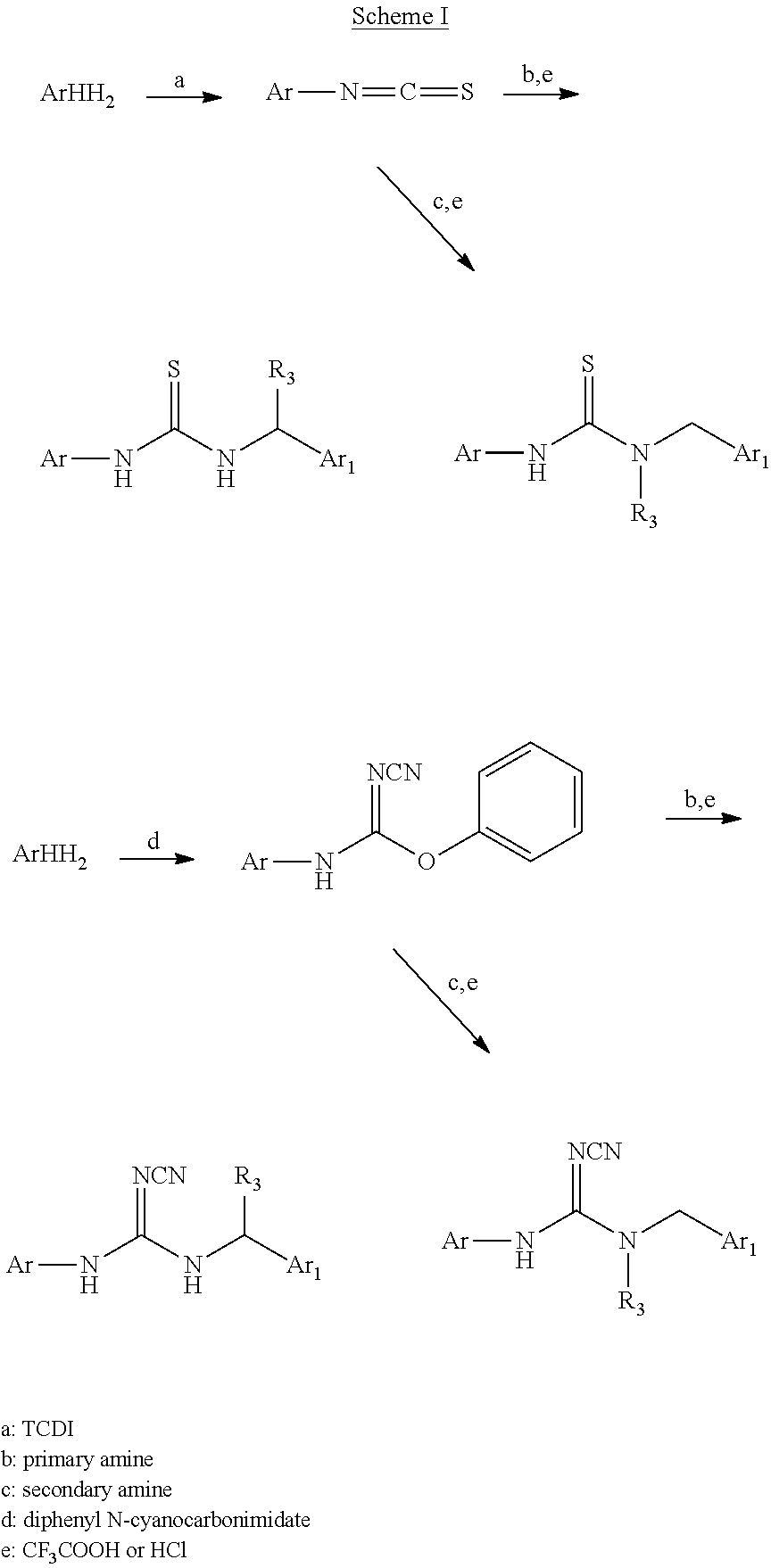
C00015

C00016

C00017

C00018

C00019

C00020

C00021

C00022
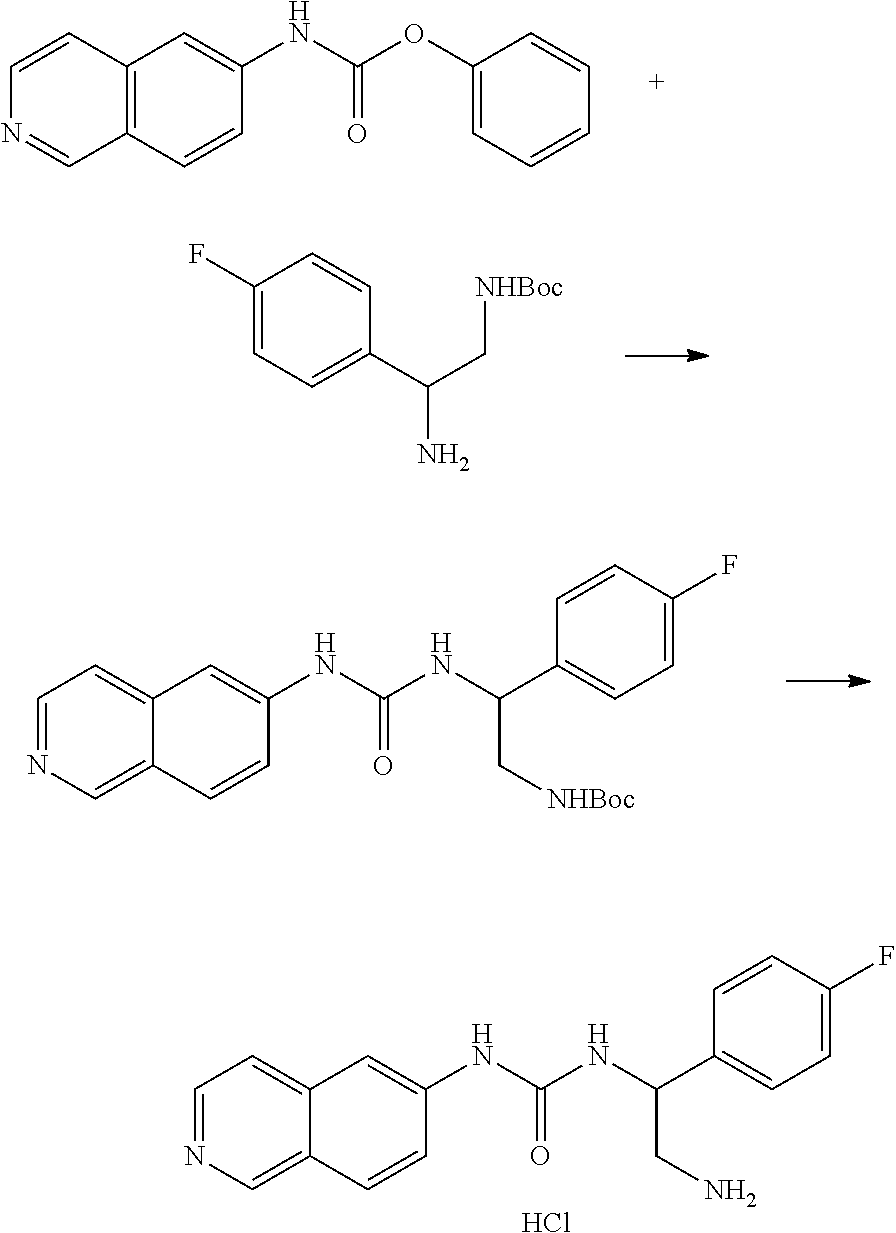
C00023

C00024
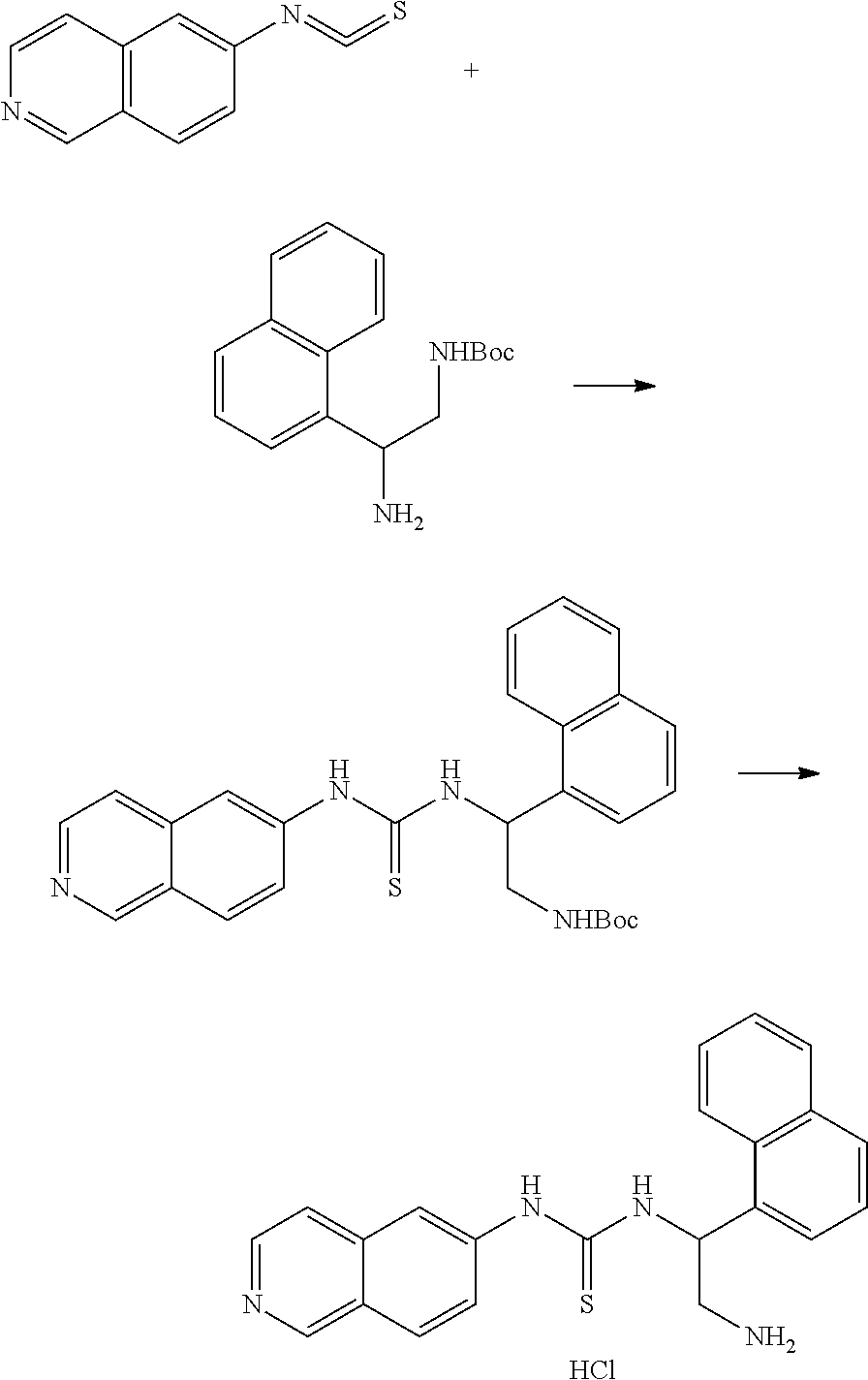
C00025

C00026
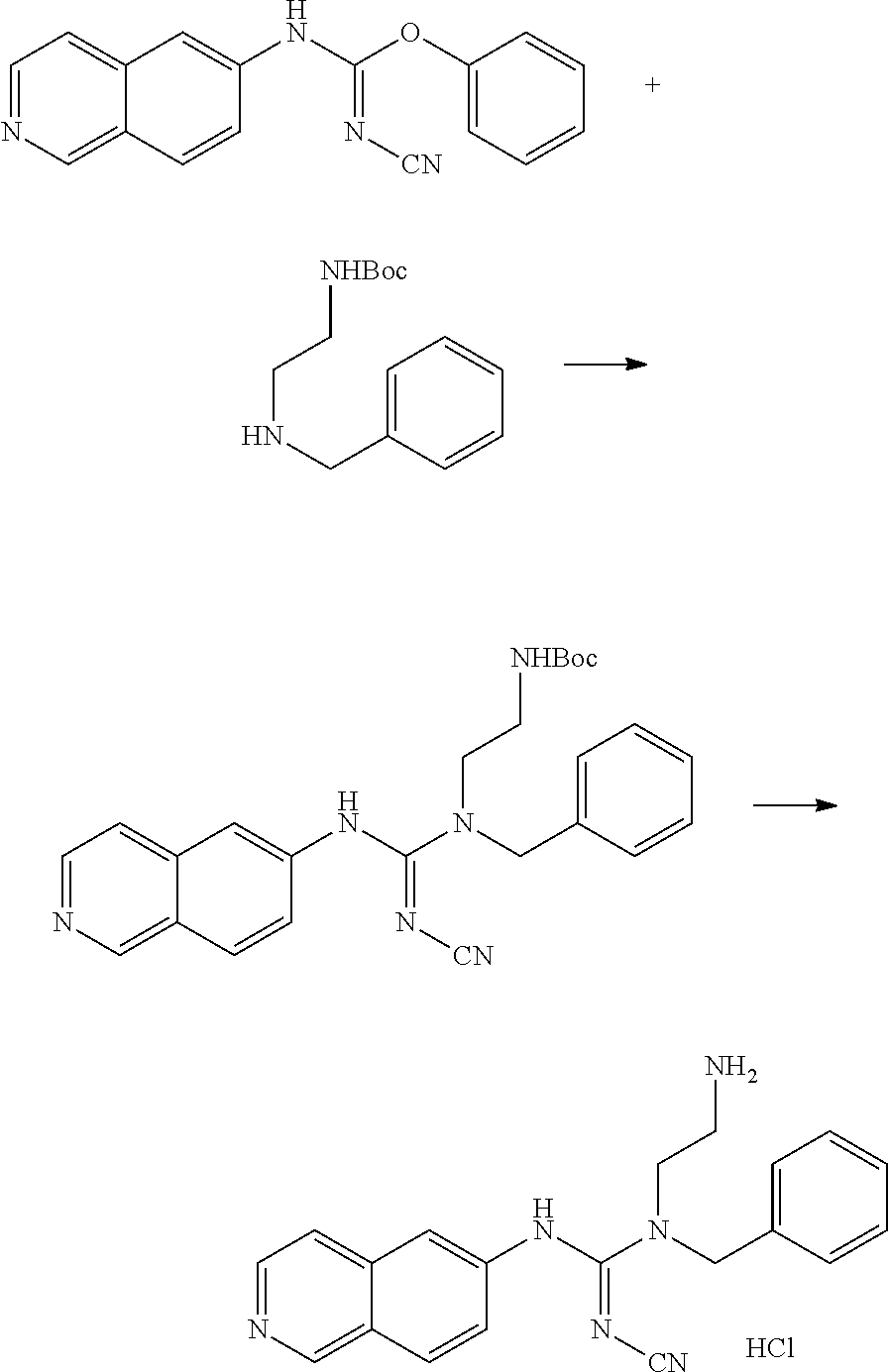
C00027

C00028
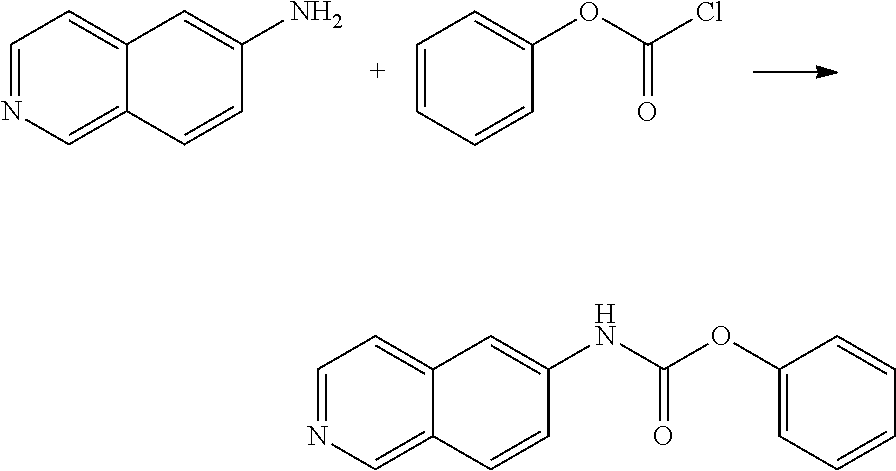
C00029
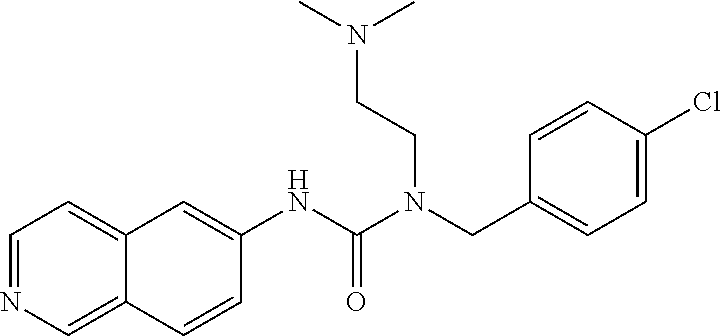
C00030

C00031
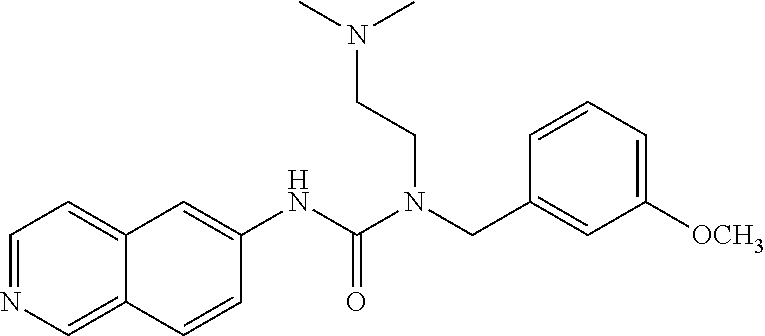
C00032

C00033
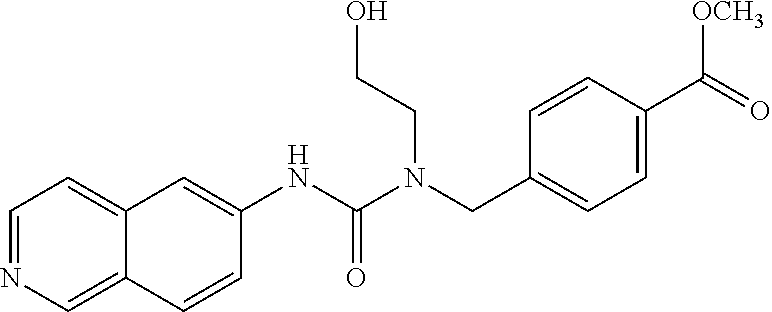
C00034
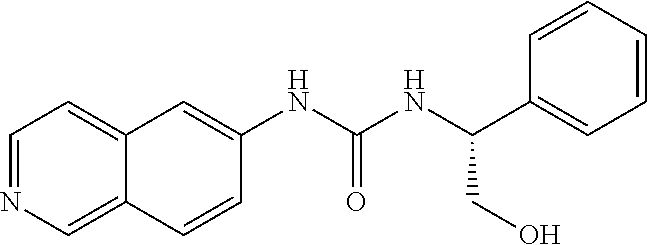
C00035

C00036

C00037

C00038

C00039

C00040

C00041

C00042

C00043
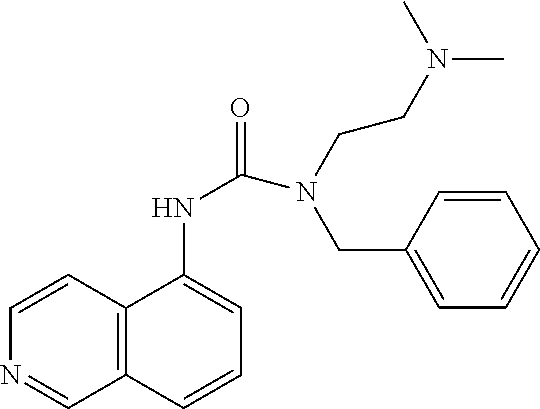
C00044
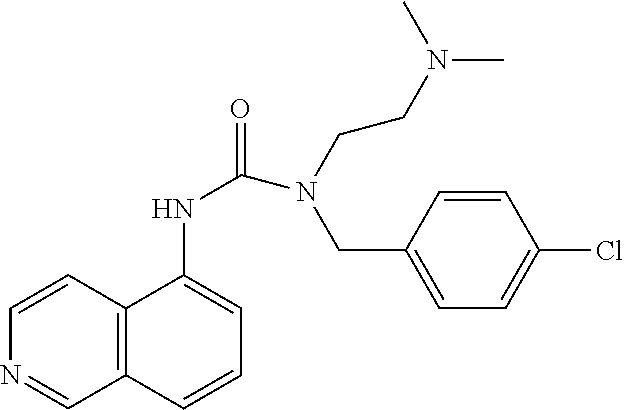
C00045

C00046

C00047

C00048

C00049

C00050
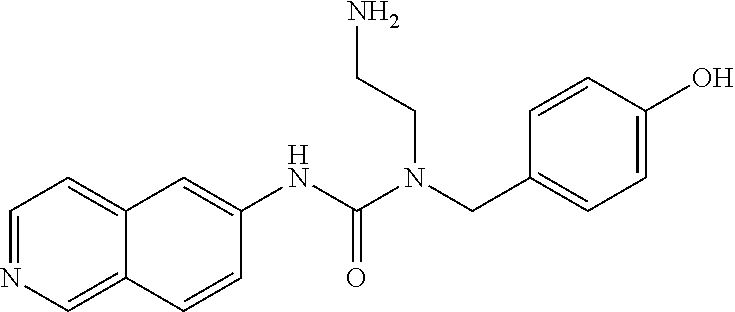
C00051

C00052
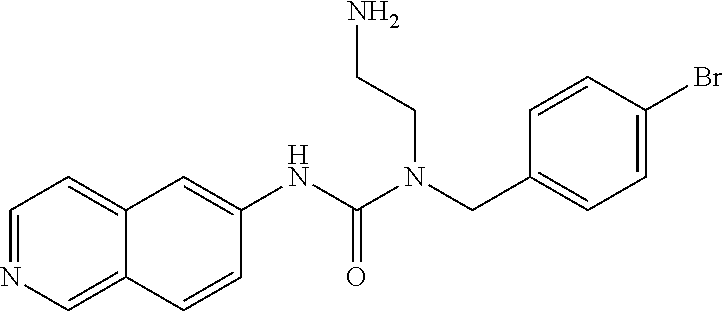
C00053

C00054

C00055
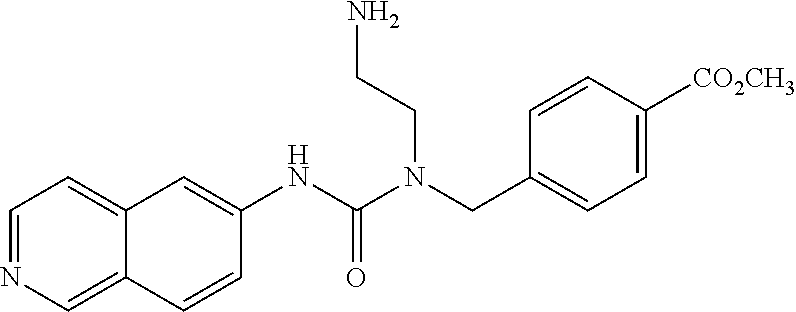
C00056
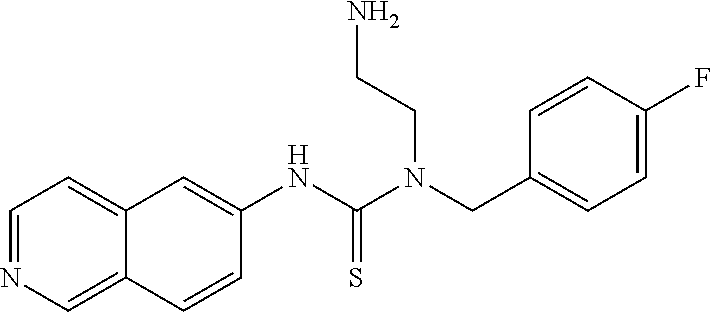
C00057
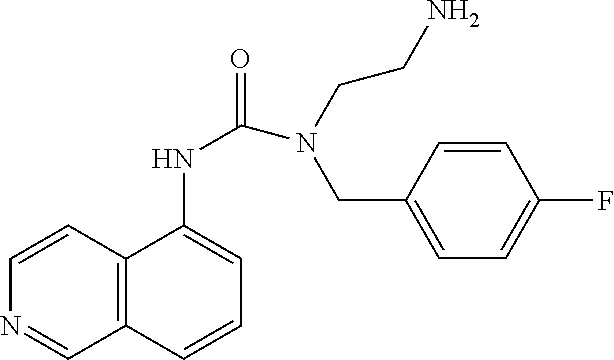
C00058

C00059
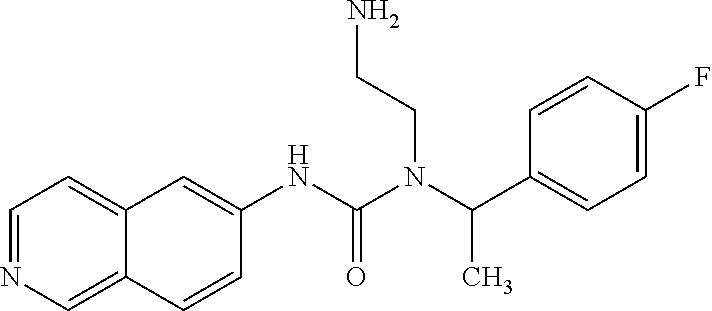
C00060
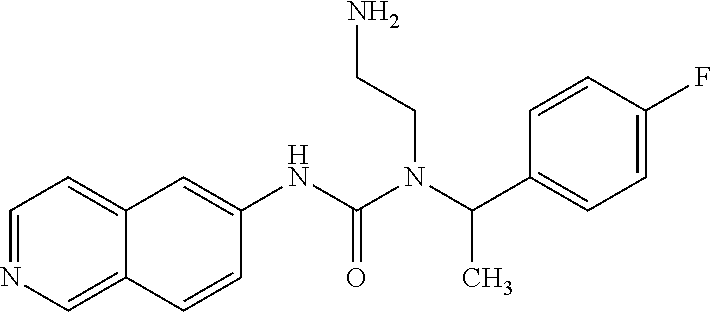
C00061

C00062

C00063

C00064
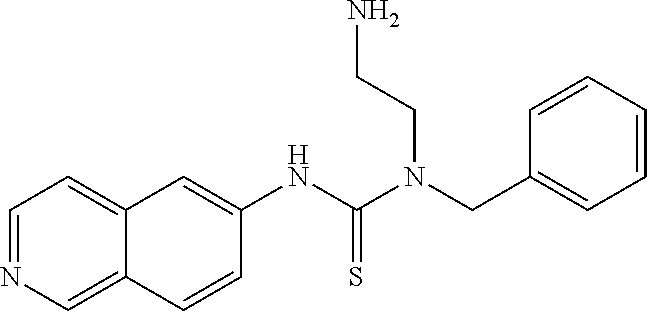
C00065

C00066
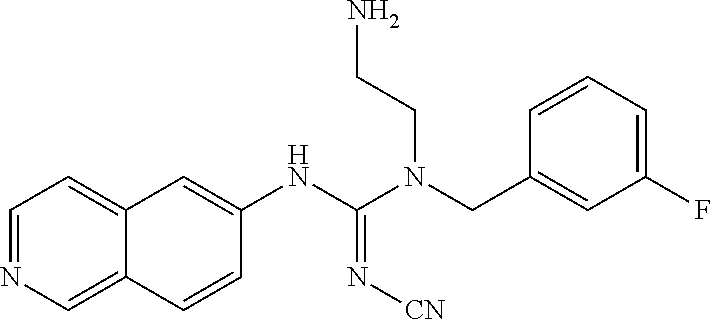
C00067

C00068

C00069

C00070

C00071

C00072

C00073
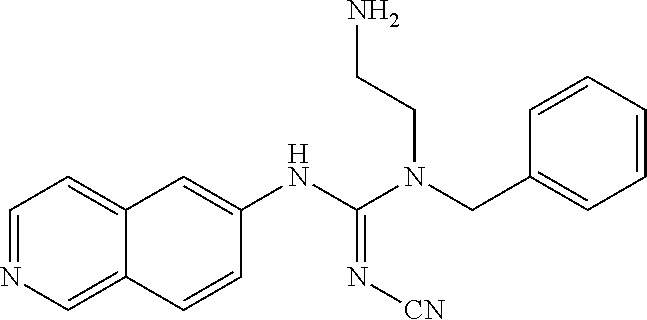
C00074

C00075
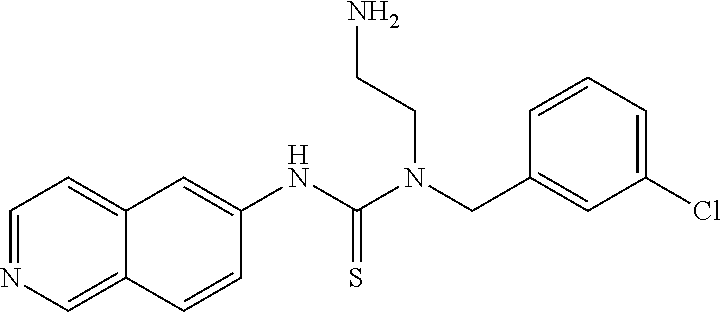
C00076

C00077
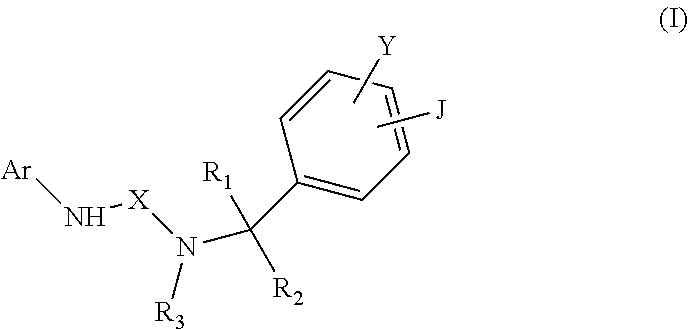
C00078

C00079
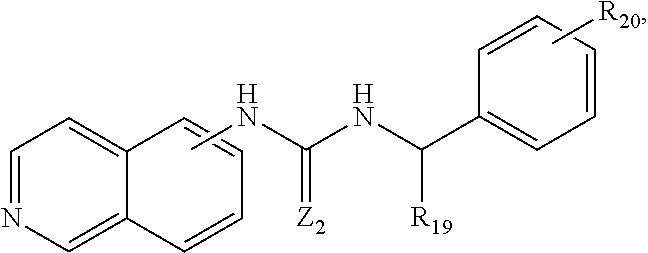
XML
uspto.report is an independent third-party trademark research tool that is not affiliated, endorsed, or sponsored by the United States Patent and Trademark Office (USPTO) or any other governmental organization. The information provided by uspto.report is based on publicly available data at the time of writing and is intended for informational purposes only.
While we strive to provide accurate and up-to-date information, we do not guarantee the accuracy, completeness, reliability, or suitability of the information displayed on this site. The use of this site is at your own risk. Any reliance you place on such information is therefore strictly at your own risk.
All official trademark data, including owner information, should be verified by visiting the official USPTO website at www.uspto.gov. This site is not intended to replace professional legal advice and should not be used as a substitute for consulting with a legal professional who is knowledgeable about trademark law.